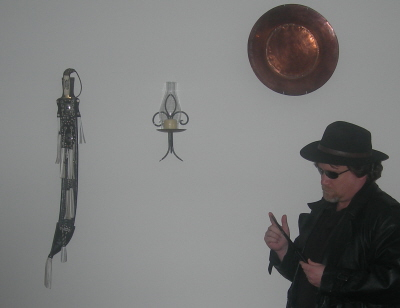|
About This Author
Come closer.
|
Complex Numbers
Complex Numbers
A complex number is expressed in the standard form a + bi, where a and b are real numbers and i is defined by i^2 = -1 (that is, i is the square root of -1). For example, 3 + 2i is a complex number.
The bi term is often referred to as an imaginary number (though this may be misleading, as it is no more "imaginary" than the symbolic abstractions we know as the "real" numbers). Thus, every complex number has a real part, a, and an imaginary part, bi.
Complex numbers are often represented on a graph known as the "complex plane," where the horizontal axis represents the infinity of real numbers, and the vertical axis represents the infinity of imaginary numbers. Thus, each complex number has a unique representation on the complex plane: some closer to real; others, more imaginary. If a = b, the number is equal parts real and imaginary.
Very simple transformations applied to numbers in the complex plane can lead to fractal structures of enormous intricacy and astonishing beauty.
November 21, 2022 at 12:02am November 21, 2022 at 12:02am
| |
One of the more interesting branches of folklore is kidlore.
Though I'm pretty sure some of the stuff circulating in school when I was a kid would get someone in huge trouble nowadays.
For example, we had a song we sang to the tune of "Battle Hymn of the Republic:"
Mine eyes have seen the glory of the burning of the school
We have wiped out all the teachers, we have broken every rule
We got sent up to the office and we shot the principal
Our school is burning down
Glory, glory, hallelujah!
Teacher hit us with the ruler
Glory, glory hallelujah
Our school is burning down
...yep, these days that would result in forced therapy at best and juvie at worst. Just for singing it.
You might not think of typing “BOOBS” on a calculator as cultural heritage, but it is.
Definitely. We also would type 7734 which, when turned upside down, said "hell." This was the height of hilarity in like 4th grade. In our defense, this was very early in the history of pocket calculators. They ran on 9V batteries and the screen was red LED, and most of them could do no more than add, subtract, multiply, and divide. And spell hell and boobs.
This sacred communal knowledge, along with other ephemera of youth—the blueprints for a cootie catcher, the words to a jump-rope rhyme, the rhythm of a clapping game—is central to the experience of being a kid.
We didn't call 'em cootie catchers. In fact, cooties were kind of a foreign concept in my school, something talked about like it was from another culture. No, what they're calling a cootie catcher, we called a fortune teller, and there were intricate ways of labeling and using the thing.
When children are together, they develop their own rituals, traditions, games, and legends—essentially, their own folklore, or, as researchers call it, “childlore.”
I like my "kidlore" better. Rolls off the tongue more easily.
Even seemingly more modern inventions, such as the “cool S”—a blocky, graffiti-ish S that has been etched into countless spiral-bound notebooks—are a shared touchstone for many people who grew up in different times and places in the U.S.
The main graphic at the link displays the S in question. I always somehow associated it with the band Styx, even though their stylized logo S was somewhat different.
Indeed, thinking back to the lore of my own youth, I have no idea how my friends and I thought to give each other “cootie shots” with the lead of a mechanical pencil, or why everyone in my elementary-school art class would smear their hands with Elmer’s glue, wait for it to dry, and then methodically peel it off (other than the fact that it was super fun and I would do it again right now if I had some glue nearby). These things were almost like analog memes, micro-bits of culture that seemed to come from nowhere and everywhere.
I'mma stop you right there: "almost like analog memes," my ass. You know what the actual definition of a meme is? Unlike kidlore, we know exactly where and when the word and concept of "meme" came from: Richard Dawkins, who meant it as "a unit of cultural transmission" and the definition got into a dictionary as "an element of a culture or system of behavior that may be considered to be passed from one individual to another by nongenetic means, especially imitation." By the definition of meme, kidlore is memes, full stop, end of discussion.
Labeling funny images with text "memes" came later. I'm not saying it's wrong; definitions change and in the immortal words of Robert Plant, you know sometimes words have two meanings. But saying that a particular bit of kidlore is "like" a meme is ignorant as shit; it is absolutely a meme.
Anyway...
The main way childlore spreads is, perhaps obviously, by children teaching it to one another. Older kids mentor younger ones both at school and at home, where siblings play a vital role in passing jokes and games down through generations.
And most of this lore is stuff that would horrify parents, who will conveniently forget that they participated in the same rituals as kids.
Parents and teachers share nursery rhymes, folk songs, and games with kids, and adults create the movies, books, and TV shows that kids consume.
Yeah, but those are deliberately sanitized, adult propaganda to convey what adults think children should know. Kidlore is different, and often includes elements that would never make it into a Disney movie. Like the song parody above, or one of the many racist chants I was subjected to as a kid.
The author does point this out later, albeit parenthetically.
Although some elements of childlore last and last, others come and go with the culture of the moment. But even then, Willett told me, kids often build on what came before, whether they realize it or not. For instance, COVID-19 has shown up in many kids’ games, including coronavirus tag— which is, of course, built on one of the most classic kids’ games there is. (Roud suspects that in Victorian times, European children played cholera tag or something similar.)
Interestingly enough, the rhyme "Ring around the rosie" was not,  as is commonly assumed, about the Plague. as is commonly assumed, about the Plague.
Another example Willett gave, from one of her studies, was a game based on the Weeping Angels from Doctor Who—monsters that can move only when you’re not looking at them.
I just gotta say, that's awesome.
And so, as we come of age, we may lose an understanding of something we once knew in our very bones: that typing 8-0-0-8-5 on a calculator is not just naughty and fun, but important. The rebellious thrill, the intense comradery, the urge to pass the knowledge along (and pretend you came up with it yourself)—all of these things fade with time.
I'm sure there's a lot of it I've forgotten. But I knew then, and I know now, that these things were important. And they were just as much a part of learning as any formal schooling. Rhyming taught me wordplay. Figuring out how to make a simple pocket calculator say a naughty word led to my interest in computers (now I can make them say ALL the naughty words). Folding and scribbling on a fortune-teller led to an interest in random numbers and topology.
The racist chants, though, those I could have done without... but I guess they taught me that some people are best avoided. By which I mean the ones perpetuating those memes. |
© Copyright 2025 Robert Waltz (UN: cathartes02 at Writing.Com). All rights reserved.
Robert Waltz has granted InkSpot.Com, its affiliates and its syndicates non-exclusive rights to display this work.
|

